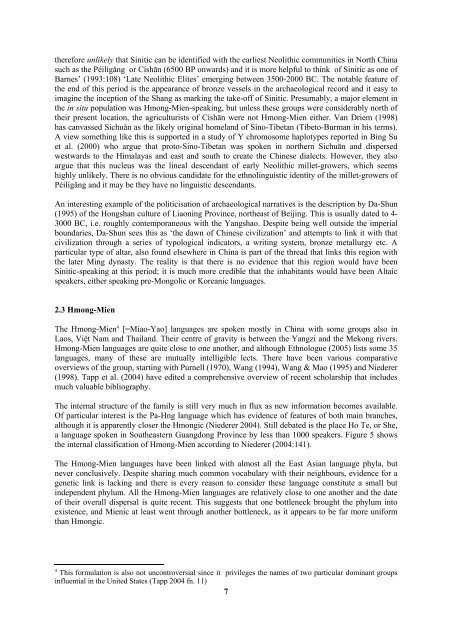Geneva paper 2004 submit.pdf - Roger Blench
Geneva paper 2004 submit.pdf - Roger Blench
Geneva paper 2004 submit.pdf - Roger Blench
You also want an ePaper? Increase the reach of your titles
YUMPU automatically turns print PDFs into web optimized ePapers that Google loves.
therefore unlikely that Sinitic can be identified with the earliest Neolithic communities in North China<br />
such as the Péilígǎng or Císhān (6500 BP onwards) and it is more helpful to think of Sinitic as one of<br />
Barnes’ (1993:108) ‘Late Neolithic Elites’ emerging between 3500-2000 BC. The notable feature of<br />
the end of this period is the appearance of bronze vessels in the archaeological record and it easy to<br />
imagine the inception of the Shang as marking the take-off of Sinitic. Presumably, a major element in<br />
the in situ population was Hmong-Mien-speaking, but unless these groups were considerably north of<br />
their present location, the agriculturists of Císhān were not Hmong-Mien either. Van Driem (1998)<br />
has canvassed Sichuān as the likely original homeland of Sino-Tibetan (Tibeto-Burman in his terms).<br />
A view something like this is supported in a study of Y chromosome haplotypes reported in Bing Su<br />
et al. (2000) who argue that proto-Sino-Tibetan was spoken in northern Sichuān and dispersed<br />
westwards to the Himalayas and east and south to create the Chinese dialects. However, they also<br />
argue that this nucleus was the lineal descendant of early Neolithic millet-growers, which seems<br />
highly unlikely. There is no obvious candidate for the ethnolinguistic identity of the millet-growers of<br />
Péilígǎng and it may be they have no linguistic descendants.<br />
An interesting example of the politicisation of archaeological narratives is the description by Da-Shun<br />
(1995) of the Hongshan culture of Liaoning Province, northeast of Beijing. This is usually dated to 4-<br />
3000 BC, i.e. roughly contemporaneous with the Yangshao. Despite being well outside the imperial<br />
boundaries, Da-Shun sees this as ‘the dawn of Chinese civilization’ and attempts to link it with that<br />
civilization through a series of typological indicators, a writing system, bronze metallurgy etc. A<br />
particular type of altar, also found elsewhere in China is part of the thread that links this region with<br />
the later Ming dynasty. The reality is that there is no evidence that this region would have been<br />
Sinitic-speaking at this period; it is much more credible that the inhabitants would have been Altaic<br />
speakers, either speaking pre-Mongolic or Koreanic languages.<br />
2.3 Hmong-Mien<br />
The Hmong-Mien 4 [=Miao-Yao] languages are spoken mostly in China with some groups also in<br />
Laos, Việt Nam and Thailand. Their centre of gravity is between the Yangzi and the Mekong rivers.<br />
Hmong-Mien languages are quite close to one another, and although Ethnologue (2005) lists some 35<br />
languages, many of these are mutually intelligible lects. There have been various comparative<br />
overviews of the group, starting with Purnell (1970), Wang (1994), Wang & Mao (1995) and Niederer<br />
(1998). Tapp et al. (<strong>2004</strong>) have edited a comprehensive overview of recent scholarship that includes<br />
much valuable bibliography.<br />
The internal structure of the family is still very much in flux as new information becomes available.<br />
Of particular interest is the Pa-Hng language which has evidence of features of both main branches,<br />
although it is apparently closer the Hmongic (Niederer <strong>2004</strong>). Still debated is the place Ho Te, or She,<br />
a language spoken in Southeastern Guangdong Province by less than 1000 speakers. Figure 5 shows<br />
the internal classification of Hmong-Mien according to Niederer (<strong>2004</strong>:141).<br />
The Hmong-Mien languages have been linked with almost all the East Asian language phyla, but<br />
never conclusively. Despite sharing much common vocabulary with their neighbours, evidence for a<br />
genetic link is lacking and there is every reason to consider these language constitute a small but<br />
independent phylum. All the Hmong-Mien languages are relatively close to one another and the date<br />
of their overall dispersal is quite recent. This suggests that one bottleneck brought the phylum into<br />
existence, and Mienic at least went through another bottleneck, as it appears to be far more uniform<br />
than Hmongic.<br />
4 This formulation is also not uncontroversial since it privileges the names of two particular dominant groups<br />
influential in the United States (Tapp <strong>2004</strong> fn. 11)<br />
7
















